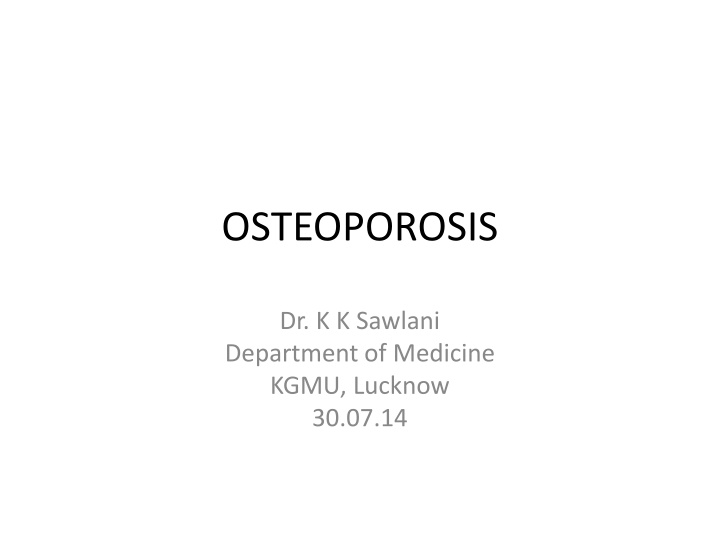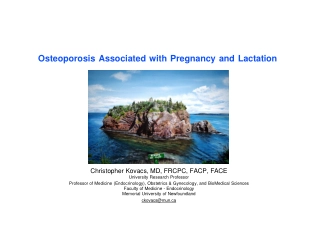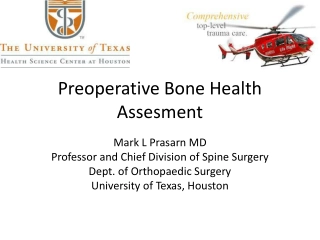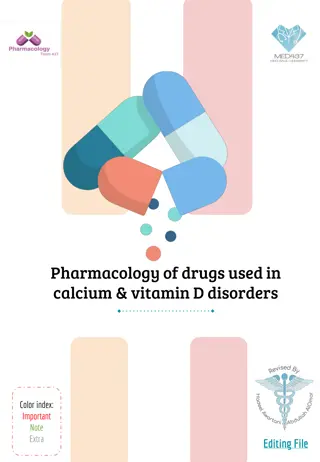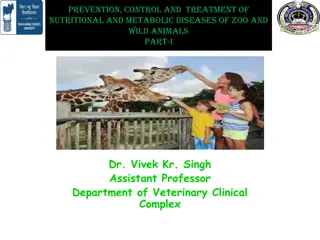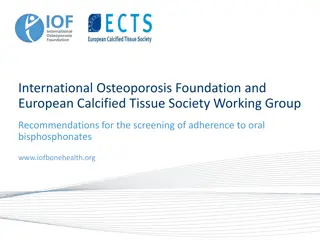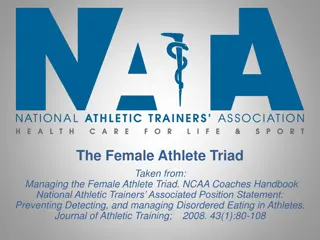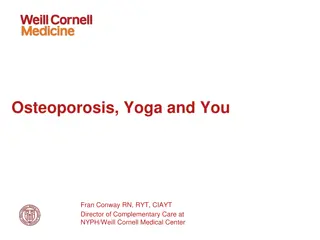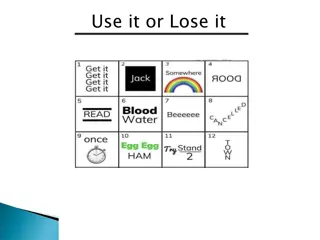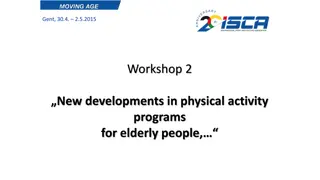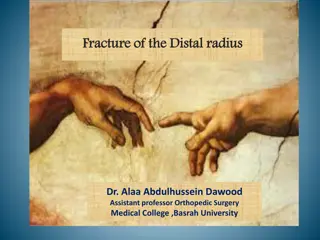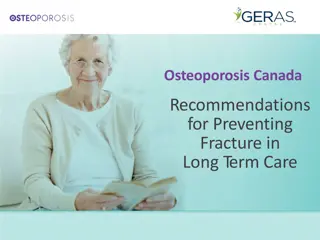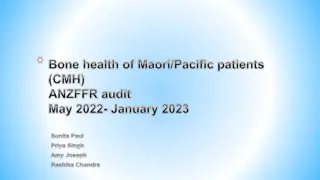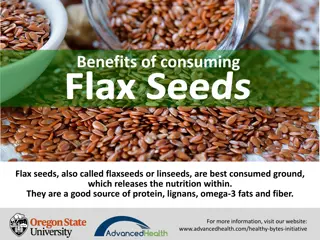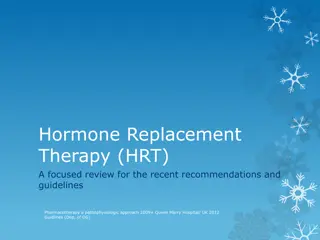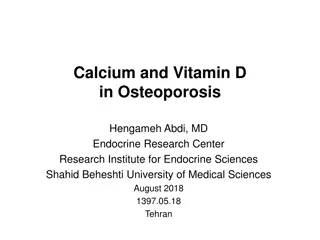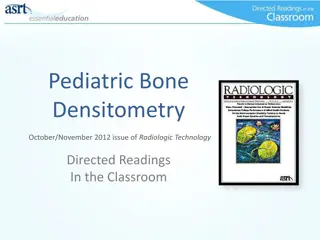OSTEOPOROSIS
A disease characterized by low bone mass and deteriorated bone tissue, leading to increased fracture risk. It affects millions worldwide, particularly the elderly, and can result in serious complications like hip fractures. Understanding the pathophysiology and age-related changes in bone mass is crucial for prevention and management. Images depicting vertebral, hip, and wrist fractures illustrate the severity of osteoporosis and the importance of early diagnosis and treatment.
Download Presentation

Please find below an Image/Link to download the presentation.
The content on the website is provided AS IS for your information and personal use only. It may not be sold, licensed, or shared on other websites without obtaining consent from the author.If you encounter any issues during the download, it is possible that the publisher has removed the file from their server.
You are allowed to download the files provided on this website for personal or commercial use, subject to the condition that they are used lawfully. All files are the property of their respective owners.
The content on the website is provided AS IS for your information and personal use only. It may not be sold, licensed, or shared on other websites without obtaining consent from the author.
E N D
Presentation Transcript
OSTEOPOROSIS Dr. K K Sawlani Department of Medicine KGMU, Lucknow 30.07.14
OSTEOPOROSIS A disease characterized by low bone mass (reduced bone density) and micro-architectural deterioration of bone tissue, leading to enhanced bone fragility and a consequent increase in fracture risk. Most common bone disease Affects million of people worldwide
Development of osteoporotic bone Rizzoli R ed In Atlas of Postmenopausal Osteoporosis (1st edition) Science Press, 2004
OSTEOPOROSIS Fractures related to osteoporosis affect around 30 % of women and 12 % of men in developed countries. Major public health problem Osteoporotic fractures can affect any bone The most common sites are Spine (vertebral fracture) Forearm (Colles fracture) Hip
OSTEOPOROSIS Hip fractures are the most serious Immediate mortality is about 12 % Continued increase in mortality of about 20 % when compared with age matched controls. Account for the majority of health care cost associated with osteoporosis.
OSTEOPOROSIS The prevalence increases with age reflecting that bone density decreases with age especially in women Accompanied by increased risk of fractures Fall in bone density Increased risk of falling
Pathopysiology Occurs because of defect in attaining peak bone mass and/or because of accelerated bone loss. In normal individuals bone mass increases to reach a peak between the age of 20 and 40 years but falls thereafter.
Age-related changes in bone mass Attainment of peak bone mass Consolidation Age-related bone loss Menopause Bone mass Men Fracture threshold Women 0 10 20 30 40 50 60 Age (years) Compston JE. Clin Endocrinol 1990; 33: 653 682.
Pathopysiology Peak bone mass and bone loss are regulated by both genetic and environmental factors. Polymorphisms have been identified in several genes that contribute to pathogenesis. Many of these are in the RANK and Wnt signaling pathways which play critical role in regulating bone turnover.
Major risk factors Non modifiable Age Race Female gender Early menopause Slender build Positive family history Modifiable Low calcium intake Low vitamin D intake Estrogen deficiency Sedentary lifestyle Cigarette smoking Alcohol excess (> 2 drinks/day) Caffeine excess (> 2 servings / day)
Post menopausal osteoporosis Most common cause Accelerated phase of bone loss after menopause due to estrogen deficiency. Causes uncoupling of bone resorption and bone formation Amount of bone reduced by osteoclasts exceeds the rate of new bone formation by osteoblasts Early menopause ( before the age of 45 years ) is important risk factor
Male osteoporosis Less common in men Secondary cause can be identified in 50% of cases The most common causes are Hypogonadism Corticosteroid use Alcoholism Testosterone deficiency results in increase in bone turnover and uncoupling of bone resorption and bone formation. Genetic factors important in the cases with no identifiable cause.
Corticosteroid induced osteoporosis Risk increases with prednisolone use 5-7.5 mg daily for more than 3 months. Reduced bone formation due to Inhibitory effect on osteoblast function Osteoblast and osteocyte apoptosis Also reduce serum calcium Inhibit intestinal calcium absorption Renal leak of calcium Secondary hyperparathyroidism with increased bone resorption Hypogonadism may also occur with high doses.
Secondary causes of osteoporosis Endocrine disease Hypogonadism Hyperthyroidism Hyperparathyroidism Cushing,s disease Inflammatory disease Inflammotory bowel disease Ankylosing spondylitis RA Gastrointestinal Malabsorption Chronic liver disease Lung disease COPD Cystic fibrosis Drugs Miscellaneous
Secondary causes of osteoporosis Drugs Corticosteroids Thyroxine over-replacement Anticonvulsants GnRH agonists Thiazolidinediones- pioglitazone Alcohol intake Heparin
Secondary causes of osteoporosis Miscellaneous Myeloma HIV infection Systemic masotcytosis Renal failure BMI < 18 Anorexia nervosa Heavy smokers
Clinical Features Asymptomatic until a fracture occurs Incidental osteopenia on X-ray performed for other reasons. Spine fracture Acute back pain ( 1/3 cases) gradual loss of height , kyphosis and chronic pain Peripheral fracture Local pain, tenderness and deformity Often with an episode of minimal trauma
Investigations Measurement of bone mineral density (BMD) by dual energy X-ray absorptiometry (DEXA). BMD can also be measured by computed tomography (CT) and ultrasound. Central (spine and hip) are best predictors of fracture risk. Peripheral( radius, heel and hands) are less expensive and widely available.
Investigations T-Score: The number of SDs the patient value is below or above the mean value for young normal subjects. Good predictor of fracture risk Z-score: The number of SDs the patient value is below or above the mean value for age matched normal controls. Whether or not the BMD is appropriate for age. Absolute BMD: expressed in g/cm2 Used to calculate changes in BMD during follow up.
Diagnosis Any patient who sustains a fragility fracture. On the basis of BMD T-score -1 = normal Between -1 and -2.5 = Osteopenia -2.5 = Osteoporisis
Changes in BMD with age (T-score values) Souce- Davidsons textbook of Medicine 22nd edition
Diagnosis History: early menopause, smoking, excessive alcohol intake, corticosteroid therapy Examination: Signs of endocrine disease, neoplasia, and inflammatory diseases A history of fall should be taken Unstable gait and unsteadiness
Diagnosis - Investigations Renal function Alkaline phosphatase Serum calcium, Vit D 25 (OH) Parathyroid (PTH) Thyroid function tests Immunoglobulins and ESR Celiac disease antibody testing Testosterone (men) 24 hour urine calcium, sodium and creatinine.
Management The aim of treatment is to reduce the risk of fractures Non-pharmacological Pharmacological
Non Pharmacological Treatment Smoking cessation Moderation of alcohol intake Adequate dietary calcium intake Exercise Vitamin D Fall prevention Good nutrition
Pharmacological Treatment Several drugs have been shown to reduce the risk of osteoporotic fractures. Effect on vertebral and non-vertebral fracture is variable. Considered with BMD T-score < 2.5 BMD T-score < 1.5 in corticosteroid induced Vertebral Fractures ,unless resulted from significant trauma
DXA Results T Score Classification Action Lifestyle measures. > minus 1.0 Normal Lifestyle measures. Consider specific treatment where there is ongoing risk, e.g. steroids, and in those who have had a minimal trauma fracture. < minus 1.0 > minus 2.5 Osteopenia Lifestyle measures. Prevent falls. Treatment may be indicated. < minus 2.5 Osteoporosis
CURRENT THERAPIES Anti-resorptive Anabolic Calcium, Vitamin D, lifestyle modification Adjunct to other treatments 1000-1200 mg/day of calcium 800-1200 U/day of vitamin D
Treatment Options in Osteoporosis Antiresorptive drugs Bisphosphonates Etidronate Alendronate Risedronate Ibandronate Zoledronate Denosumab (monoclonal antibody against RANK-L) SERMs Raloxifene Calcitonin HRT (estrogen) Anabolic drugs Teriparatide(PTH 1-34) Dual Action Bone Agents (DABAs) Strontium ranelate
Bisphosphonates Inhibit bone resorption by binding to hydroxyapatite crystals on bone surface Osteoclasts reabsorb bone-drug released within cell- inhibt key signaling pathways. Increase in Spine BMD of 5-8% and Hip BMD 2-4%. Should be taken on an empty stomach with plain water. No food should be eaten 30-45 minutes after administration
Adverse effects of biphosphonates Common Upper GI intolerance (oral) Acute phase response(intravenous) Less Common Atrial fibrillation (IV zoledronic acid) Renal impairment (IV zoledronic acid) Atypical subtrochanteric fractures Rare Uveitis Osteonecrosis of the jaw
INDICATIONS FOR ANABOLISM Pre-existing osteoporotic fractures Very low BMD Very high fracture risk Unsatisfactory response to antiresorptive therapy Intolerant to anti-resorptive therapy
TERIPARATIDE Daily SC injection 20 mcg Maximum 18-24 months May be followed by anti-resorptive therapy PTH is expensive and is reserved for severe osteoporosis, who fail to response to other therapies. No advantage of combined anabolic and anti-resorptive therapy
Selective estrogen receptor modulator (SERM) Raloxifene 60 mg daily orally Partial agonist of estrogen receptor in bone & liver Antagonist in breast & endometrium SE: muscle cramps, hot flushes, increased risk of VTE. Bazedoxifene is a related SREM
HRT Cyclical HRT wirh estrogen and progestogen Prevents post menopausal bone loss and reduces risk of fractures in post menopausal women Primarily indicated for prevention of osteoporosis in women with early menopause Women in early fifties with troublesome menopausal symptoms. Increased risk of breast cancer and cardiovascular disease
Duration of therapy Oral biphosphonates long term (5 YRS) HRT, raloxifene continuously Denosumab continuously Strontium ranelate not established Teriparatide 2 yrs fb antiresorptive Tt
Response to drug treatment Repeat BMD measurements after 2-3 yrs. Spine BMD best for monitoring Biochemical markers ( N-telopeptide) respond more quickly; can be used to assess adherence.
Surgery Reduce and stabilize osteoporotic fractures Painful vertebral compression fractures Vertebroplasty ( Injection of MMA) Kyphoplasty ( balloon inflation MMA)
Response to Drugs Fracture risk reduction 30-40% # risk reduction with antiresorptives 60% # risk reduction with teriparatide BMD 2-3% BMD increase with anti-resorptives 4-6% BMD increase with teriparatide
Osteoporosis MCQ 1. Most common cause of osteoporosis a. Hypogonadism b. Malabsorption c. Post menopausal d. Hyperparathyroidism
Osteoporosis MCQ 2. Most common bone disease is a. Osteomalacia b. Osteoporosis c. Secondaries bone d. Osteopetrosis
Osteoporosis MCQ 3. Which of the following drug is most common cause of drug induced osteoporosis a. Thyroxine over-relacement b. Corticosteroids c. Pioglitazone d. Anticonvulsants
Osteoporosis MCQ 4. Osteopenia is defined as T- Score of a. < -1 b. < -1 to < -2.5 c. < -2.5 d. None of the above
Osteoporosis MCQ 5. Risk of fracture in osteoporosis is best predicted by a. T-score b. Z-score c. Absolute BMD d. Serum calcium levels
Osteoporosis MCQ 6. Risk factors for osteoporosis are all except a. BMI > 30 b. Smoking c. Low calcium intake d. Immobilization
